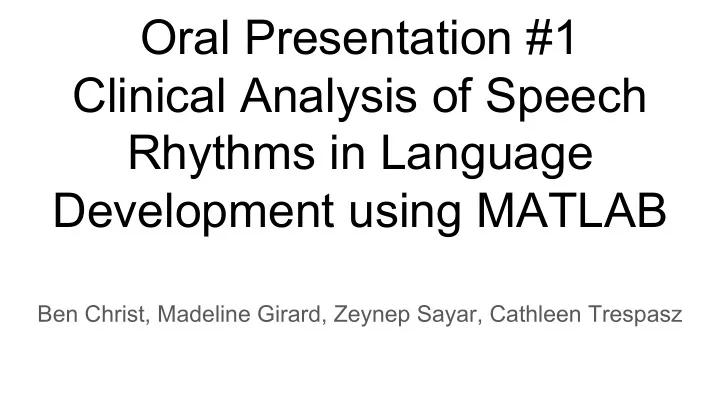

Oral Presentation #1 Clinical Analysis of Speech Rhythms in Language Development using MATLAB Ben Christ, Madeline Girard, Zeynep Sayar, Cathleen Trespasz
What is Specific Language Impairment? ● Specific Language Impairment (SLI) is a language-disorder where patients exhibit decreases in ability to form proper grammar and can also have decreased vocabulary. ● People with SLI have also been shown to have a decreased ability perceive and produce rhythmic language.
Numerical Representation of SLI ● Creation of phrases to have half and whole note emphasis (Dig For a Dog) ● Matched metronome beat to phrase ● Patients would listen to metronome and attempt to construct given phrase to the proper metronome beat ● Analyzed using circular statistics ○ Regards metronome as perfect and records the phase lag or anticipation of when speech was produced. (SHOW GRAPH HERE) ○ Final product is unit vector representing both how precise and accurate the data is.
Problem Statement Preliminary research has been conducted that indicates a correlation exists between an individual’s rhythmic capabilities and language development. Currently, the data analysis process used to determine an individual’s rhythmic abilities is inefficient and impractical in a clinical setting. No data analysis process or system exists to assess an individual’s speech rhythm. There is a need in the industry for a diagnostic technique that efficiently analyzes the individual’s recorded speech to determine whether their rhythm is considered good or bad. There is an immediate need in the Gordon lab for a data analysis process that quickly and efficiently judges rhythm in speech. Beyond the Gordon lab, there is a clinical need for a device with an intuitive interface that is capable of immediate analysis and display of feedback
Needs Assessment ● Must: ○ Detect the rhythm of the English language. ○ Detect the rhythm of various types of music. ○ Compare rhythms of English language and music. ● Data collected from instrument should be stored for analysis and future retrieval. ● Design must not exceed NIH grant budget. ● Instrument must be safe , physically compatible with children, and comfortable . ● Design must allow for variability between patient speech and disorders. ● Lab setting must induce positive reinforcement for child compliance. ● Must be compatible with data files of past research.
Needs Assessment Newer needs: ● Must streamline data in one software program ● Must reduce time needed to analyze data ● Must use consistent analytics ● Must provide feedback to user and lab staff ● Must have intuitive interface
Software Design Components ● MATLAB program: ○ Collect and analyze speech and metronome tracks ○ Utilization of toolbox functions and circular statistics ○ Feedback and user interface to assess patient rhythm consistency and accuracy ● Data analysis program must be compatible with: ○ Various computer operating systems ○ A microphone ○ Headphones ● The design of the study will: ○ Determine the rhythm baseline by sampling a population of individuals with normal speech development ○ Longitudinally assess impact of musical training on speech rhythm therapy
Conclusions ● Faster analysis ○ More time to devote to actual research ○ Ability to collect and analyze more data ● A common analysis method to be used in different research labs ○ Improve consistency between data from different studies ● A verified diagnostic technique in clinics ● Therapeutical use by speech pathologists
Next Steps ● Filter and smooth the sound signal to get an intensity curve by either; ○ Translating existing code from Pratt to MATLAB ○ Use other filtering techniques ● Eliminating initial spike in amplitude ● Obtaining the metronome signal in MATLAB ● Determining the best way to compare the two signals
Recommend
More recommend